Grasp Patterns
Grasp patterns are the coordinated movements the hand uses to pick up and hold objects. These patterns affect how people learn and interact with the environment. They have a significant effect on how people participate in functional activities. Grasp patterns can influence the level of independence a person has during daily tasks.
| Grasp Pattern | Thumb Opposition Required? | Description | Example | Photo |
| Gross grasp or Cylindrical grasp | Yes | All fingers and thumb wrap around the handle of an object. -Gross grasp is often used by small children before they gain finger control.-Gross grasp can be impaired by damage to the CMC joint of the thumb, such as that which occurs with a diagnosis of osteoarthritis (OA) |
A baseball player uses gross grasp to hold on to the baseball bat. | 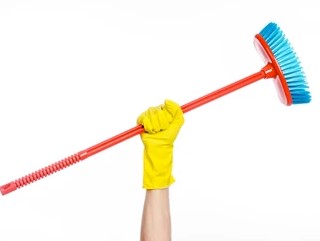 |
| Power grasp | No | A variation of cylindrical grasp, used when extra force is required. The thumb helps to stabilize the shaft of the tool rather than opposing the fingers. – The greater the effort to control an object with a power grasp, the greater the potential for injury. |
A carpenter uses a power grasp to hold a hammer while building. | 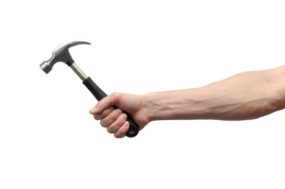 |
| Hook grasp | No | The fingers “hook” around an object, with or without added stability from the thumb.
-People with a diagnosis of radial nerve palsy are unable to form this grasp. |
A businessman uses a hook grasp to carry his briefcase. | 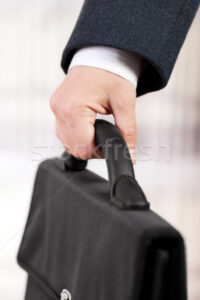 |
| Spherical grasp | Yes | The thumb and fingers form a “cup” shape to grasp a round object. | A child uses a spherical grasp to hold and eat an apple. | 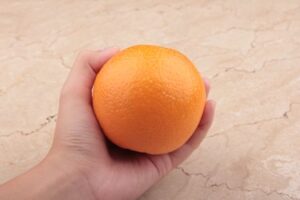 |
| Conoid grasp | Yes | The thumb and fingers oppose to hold a cone shaped object, with the apex of the cone at the ulnar side of the palm. -The ring and little fingers provide extra control and stability at the smaller end of the cone. |
A woman holds an ice cream cone while her child eats it. | 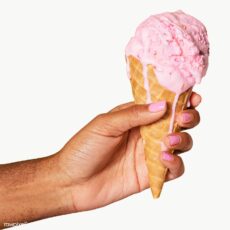 |
| Lateral pinch | No | The thumb pushes against the side of the index finger to secure an object.
-Often used to compensate for weakness or instability of the tip and palmar pinches. -Also used to compensate for poor thumb opposition. |
A man uses lateral pinch to hold his car keys while starting his car. | 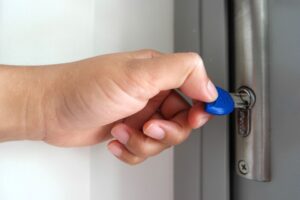 |
| Palmar pinch
-also called three jaw chuck grasp because the three fingers form a chuck similar to a drill. |
Yes | The thumb opposes against the tips of the index and middle fingers to secure a small object. | A child uses palmar pinch to pick up, place and push small building blocks together. | 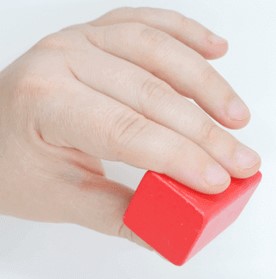 |
| Tip pinch | Yes | The thumb opposes the tip of a finger, usually the index finger, to secure a small object. | A woman uses tip pinch to pull a pin out of a pin cushion. | 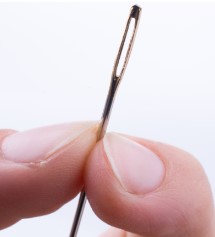 |
| Tripod grasp | Yes | A variation of palmar pinch, used to hold writing and drawing tools. The shaft of the tool is held by the tips of the thumb and index finger and stabilized by the side of the middle finger near the PIP joint. | A child uses a tripod grasp to hold his pencil while writing the alphabet. | 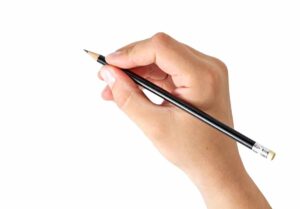 |
| Quadrupod grasp | Yes | Another variation of palmar pinch, used to hold writing and drawing tools. The shaft of the tool is held by the tips of the thumb, index and middle fingers and stabilized by the side of the ring finger near the PIP joint. | A child uses a quadrupod grasp to hold a marker while drawing on a whiteboard. | 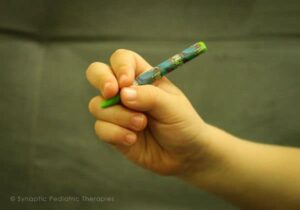 |